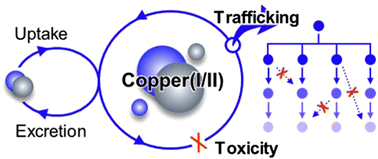Copper trafficking systems in cells: insights into coordination chemistry and toxicity
Abstract
Transition metal ions, such as copper, are indispensable components in the biological system. Copper ions which primarily exist in two major oxidation states Cu(I) and Cu(II) play crucial roles in various cellular processes including antioxidant defense, biosynthesis of neurotransmitters, and energy metabolism, owing to their inherent redox activity. The disturbance in copper homeostasis can contribute to the development of copper metabolism disorders, cancer, and neurodegenerative diseases, highlighting the significance of understanding the copper trafficking system in cellular environments. This review aims to offer a comprehensive overview of copper homeostatic machinery, with an emphasis on the coordination chemistry of copper transporters and trafficking proteins. While copper chaperones and the corresponding metalloenzymes are thoroughly discussed, we also explore the potential existence of low-molecular-mass metal complexes within cellular systems. Furthermore, we summarize the toxicity mechanisms originating from copper deficiency or accumulation, which include the dysregulation of oxidative stress, signaling pathways, signal transduction, and amyloidosis. This perspective review delves into the current knowledge regarding the intricate aspects of the copper trafficking system, providing valuable insights into potential treatment strategies from the standpoint of bioinorganic chemistry.

- This article is part of the themed collections: 2023 Frontier and Perspective articles and New Talent: Asia Pacific


 Please wait while we load your content...
Please wait while we load your content...